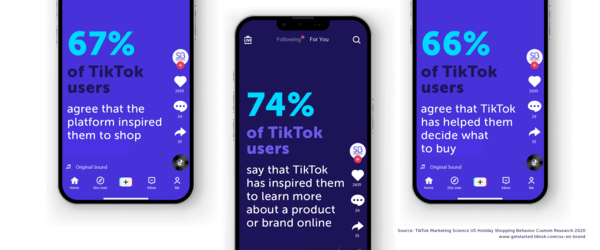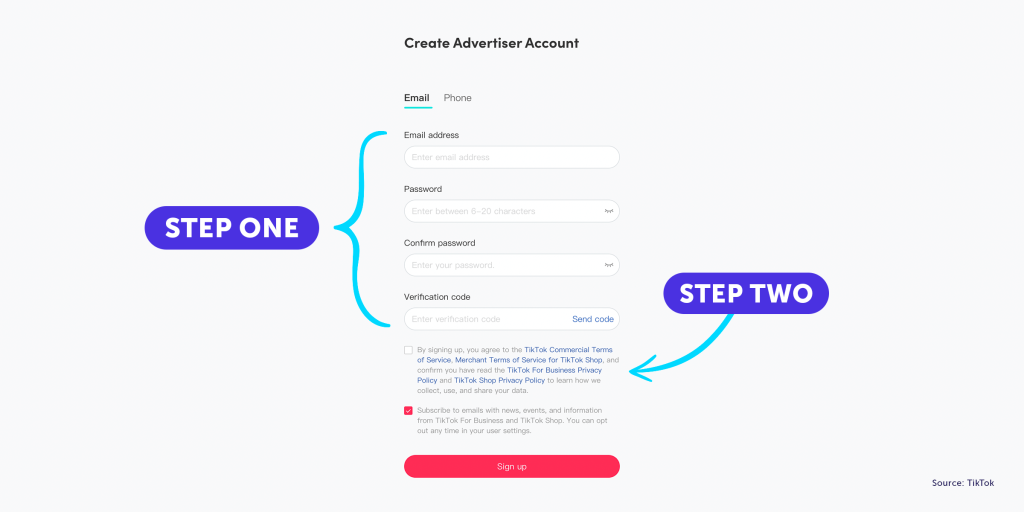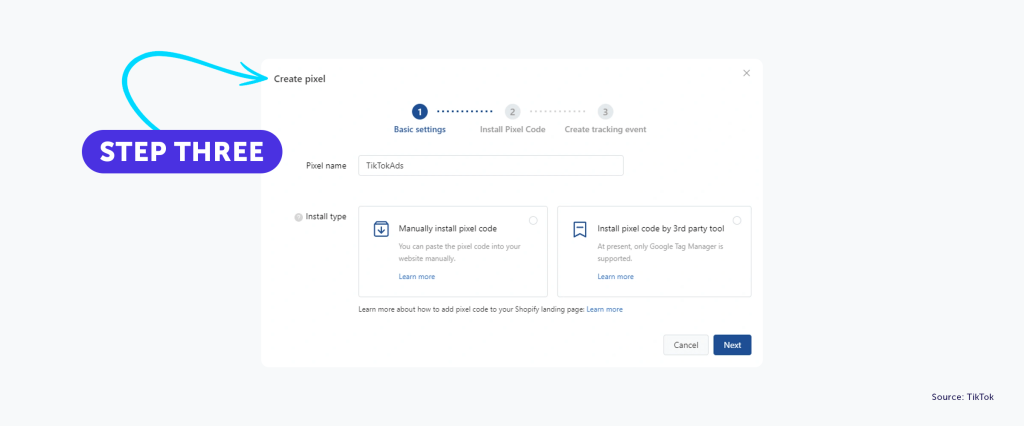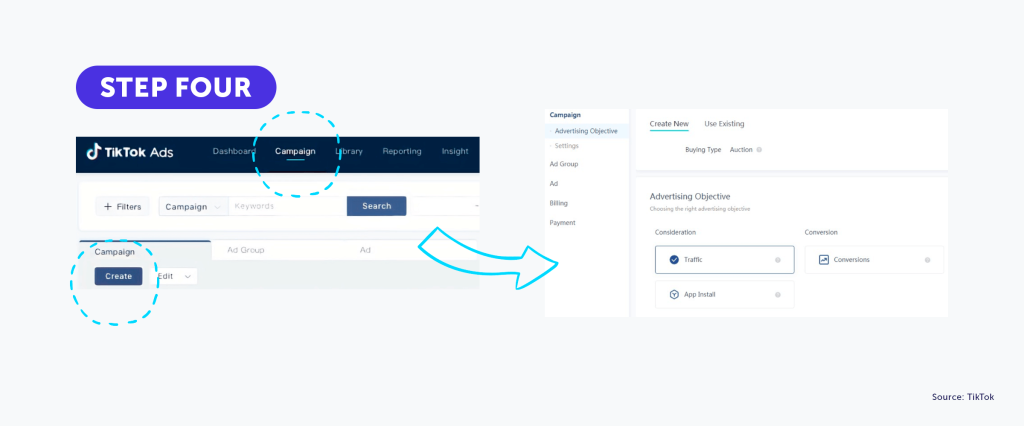Let’s talk TikTok. No, I don’t mean TikTok videos of the amazing things people do that make you go “Wow!” Or of the crazy things people do that make you go “Ow!” Instead, let’s talk about how TikTok ads can help your business grow.
In this article, I’ll explain what you need to know about marketing your business on TikTok, including steps on how to create TikTok ads and tips on how to make them more effective.
Let’s get to it.
What Is TikTok?
I first learned about TikTok after stubbing my little toe on a coffee table and dropping to my living room floor in a heap. As I mopped the hardwood with the side of my face, writhing in pain, somewhere beyond the static and stars, I saw my son holding his phone out, laughing. When I asked him what he was doing, he said “Making a TikTok.”
Later, when I found the courage to stand up, I learned what TikTok was — a social media app that lets you make, share, and discover videos. They’re usually set to catchy music or custom-made soundtracks. Most are around 15 seconds long. But they can run longer.
Some of the more popular TikTok video topics include pranks, stunts, tricks, jokes, dance, and other entertainment. I’m not sure which one I fell into, but my son said something about breakdancing.
It wasn’t long before I realized that this effective form of entertainment was also ushering in an effective form of advertising. TikTok ads!
What Are TikTok ads?
TikTok ads are immersive full-screen, sound-on videos that target viewers based on age, gender, location, interests, and more.
These ads look less like commercials or other social media ads, and more like TikTok videos themselves.
Done well, TikTok ads integrate brand and products — or services — into the video, seamlessly and authentically.
Why Use TikTok ads?
The short answer is: Huge audience and relevance. TikTok is a wildly popular social media platform with more than 148 million users in the U.S.1 alone. Hello, opportunity.
But I know what you might be thinking — do TikTok ads work? Isn’t TikTok just for young people? Is there really a place for my business on TikTok? Are TikTok ads legit?
Here’s a fact you might find interesting: Although Zoomers (ages 12-24) make up the single largest age group of users on TikTok, nearly 55% of TikTok users are actually 25 or older.2 This collective group of Millennials, Gen Xers, and Boomers has quite a bit of purchasing power.
And keep in mind, there’s even purchasing power with Gen Z. My teenage daughter bought a bunch of charm bracelets for her friends as high school graduation gifts. The idea came to her through a TikTok ad, which she clicked on and then made her purchase.
Here are more stats to consider:
According to Influencer Marketing Hub:3
- TikTok users in the U.S. spend more than 850 minutes per month on the app.
- Nine out of ten TikTok users use the app multiple times daily.
- Users are highly engaged:
- 63% liked someone else’s video
- 54% commented on a video
According to DemandSage:4
- TikTok will have 1.8 billion monthly active users by the end of 2022.
- Over 1 billion videos are watched every day on TikTok.
- Consumers in the U.S. spent approximately $110 million on the app.
And according to TikTok:5
- 67% of TikTok users agree that the platform inspired them to shop, even when they weren’t looking to do so.
- 74% of TikTok users say that TikTok has inspired them to learn more about a product or brand online.
- 66% of TikTok users agree that TikTok has helped them decide what to buy.

The takeaway here is that TikTok not only has a huge following, but a highly engaged one. Users don’t just watch what’s on the platform. They engage with the platform. That makes it a channel that has potential to promote engagement with businesses and drive sales. If you engage with the platform, you may be able to find potential customers.
Overall, here’s why TikTok ads might be right for your business:
You can reach a wider audience.
How about an app with 656 million downloads?6 That’s over 100 million downloads more than the runner-up, Instagram. And in terms of time spent on a social media platform,7 Android users spent 19.6 hours/month on TikTok, which ties it for second place with Facebook. Only YouTube surpassed TikTok.
Given these trends, it stands to reason that the more time users spend on the platform, the more ads they’ll see, and the more chances they’ll have to discover your brand. When that happens, you stand a greater chance of reaching a wider audience.
They’re surprisingly cost-effective.
TikTok ads are not free. But if you’re wondering how much do TikTok ads cost, you’ll probably be relieved to hear they typically won’t break the bank. At least not all of them.
There are currently two budgeting options: daily or lifetime.8 With both options, your budget isn’t set in stone. You can adjust it anytime throughout the campaign. If you want to start an advertising campaign, that will cost a minimum of $500.
You can set up a free TikTok Ads account and create In-Feed ads within your own budget and schedule. Currently, TikTok uses a cost per mile (CPM) metric9 to charge for ads. You can figure on $10 for every 1,000 views.
Good returns on your ad spend.
If you’re into marketing speak, then this stat might appeal to you: 90% of TikTok campaigns exceed a ROAS of $2.50, while half exceed an ROAS of $5.10
If you’re not into marketing speak, then let me break it down this way: ROAS stands for “return on ad spend”. For every dollar you spend on advertising, you obviously want to get something greater back in return.
How much greater? Most companies aim for a 4:1 ratio.11 That means for every $1 you spend, you’re likely to see $4 in revenue. The average is closer12 to 2:1.
It’s a possible indicator that if you communicate relevant advertising messages to the right audience in TikTok, the return on ad spend will likely be higher.
They’re highly targeted.
This goes hand-in-hand with the last point. TikTok users see ads based on the kind of content they engage with. If you’re a landscaper or florist, you could target your ads to people who watch gardening or other related videos.
Also, users are served these ads no matter what. There’s no opt-out ad feature on TikTok.
When you create an ad, you can set certain parameters, targeting your audience by gender, location, age, interests, and other unique variables.
You can even create “Custom Audiences” and “Lookalike Audiences” to reach new followers who are similar to your existing ones.
You can flex your creativity.
It’s more than just receiving likes and views. Advertising on social media is about creating content with purpose and value. Let’s say you’re a landscaper. You might consider providing customers with helpful tips — like how to fertilize a lawn organically.
Giving your audience content that’s useful to them may help them remember your business in the future when they have a landscaping project they don’t want to do on their own.
People remember videos.
A study by Social Media Week13 revealed “viewers claim they retain 95% of a message when obtained via video.” Also, “92% of mobile users report sharing videos with others.”
Although this data suggests the power of video, here’s something you might want to keep in mind: Although TikTok can potentially boost business, it can pose some threats, too. It’s best to be prepared. Let’s look at how to do that next.
Boost Your Business. Protect It, Too.
Just like you might consider using a powerful tool like TikTok to attempt to boost your business, you probably want to consider the use of other tools to protect your business. Like general liability insurance which can potentially protect against claims of advertising or personal injury.
For example, let’s say you create a TikTok ad and post it to the platform. A viewer makes a comment that one of your employees doesn’t like. The employee responds, diparagingthat viewer.
That could lead to a lawsuit. Your general liability policy may help cover legal fees, as well as any resulting damage payouts, up to your policy limits.
It may also protect against claims arising from faulty products. For example, let’s say you have an e-commerce business and sell hand-carved driftwood lamps.
One of the lamps has a bad wire that causes a fire in a customer’s home. If that happens, you could potentially be responsible for damages or medical expenses. Your insurance policy could help cover costs arising from that claim, again up to your policy limits.
Plus, with more e-commerce platforms requiring proof of business insurance,14 you may need it before you can run a TikTok ad anyway.
That’s where Simply Business comes in. We’re an online insurance platform that makes it extremely easy to compare affordable policy options from insurers that specialize in covering small businesses like yours.
Wondering how much insurance might cost? Check out our online tool that helps you get a free quote in just minutes. Or if you want to talk to a helpful human (one of our licensed insurance agents), you can call them at 844-654-7272.
OK, now that you understand some of the risks and how insurance may help, let’s look at the best ways to create your ads.
Get Insured in Under 10 Minutes
Get an affordable & customized policy in just minutes. So you can get back to what matters: Your business
Types of TikTok Ads
There are a few different TikTok ad formats. However, some are geared toward bigger brands with deep advertising pockets. So for the purposes of this article and small businesses, I’ll focus on a couple, which you can find on TikTok For Business:15
1. In-feed ads.
These are self-service ads you can create through the TikTok Ad Manager interface. These video ads auto-play as users scroll through videos in the “For you” feed.
2. TopView ads.
They automatically play before users ever select a particular piece of content.
To get a better sense of what these ads look like and how they work, check out these TikTok ad video examples.16
How to Run Ads on Tik Tok
Now that you’re familiar with some of the TikTok ad options, let’s look at the steps required to build one:
Step 1: Create your TikTok ad account.
First things first, you’ll need to set up an advertising account.
To do that, go to TikTok Ads Manager,17 scroll down the page, and enter some basic information such as your email address or phone number and password.
Then enter the verification code that’s either emailed or texted to you.
Step 2: Accept terms and conditions.
Next are the terms and conditions. Read those. Click the little box. And then click “Sign Up.”

Step 3: Install your TikTok pixel and set rules.
Before jumping right in and creating a campaign, you’ll need to implement your “TikTok pixel” and “set rules.”
The pixel is a measurement tool that tracks your TikTok ads’ impact on your website. The code behind it enables you to monitor sales, user activity, and find the right audience for your ads. If you don’t have a website yet, or want to upgrade yours, check out this article we wrote on the best website design for small businesses.
Setting rules lets you define a series of events along the user journey. You can choose from different options based on your business goals. Descriptions within the app section help you make the right choice.
These steps basically create the foundation from which you can build your ads — and learn how they’re doing. Which takes us to the next step.

Step 4: Create a new campaign.
To create an ad campaign, click on the “Create” button under the “Campaigns” tab. This will give you the option to choose your campaign objective — whether that’s to drive traffic to your site, convert sales, or a different objective.
Next, give your campaign a name and set a campaign-level minimum budget. If you want, you can set a daily budget, which allows you to gradually and steadily reach out to your target audience.

Step 5: Create an ad group and select placements.
Choose the audience for your ad by selecting location, gender, and age group. You can also add users with specific interests and include people who have previously interacted with your content.
This is also where you define placements for your ads. Your choice of ad placement will determine where your ads appear on TikTok and its partner platforms.
If you’re just getting started with TikTok ads, you might consider choosing “Automatic placement.” This lets TikTok place your ads for you, to ensure maximum reach and value. You also can place ads manually across TikTok and its news feed apps yourself.
Step 6: Select a delivery type.
Choose either standard or accelerated delivery. Standard delivery ensures your ad will appear during high-traffic times throughout your delivery period, with your budget spread consistently across that time frame. Accelerated delivery means your budget is dedicated to getting the most eyes on your ad as quickly as possible.
Step 7: Create a new ad.
When configuring your first ad, TikTok will give you the option to upload either a video or an image file as your ad creative. For best results, make sure you follow the recommended ad specs.18 This will ensure it looks great on TikTok.
You can further customize your ad by naming it so it’s easier to distinguish between different ads within the same ad group. Enter your ad text using 12-100 characters to get your message across. This text will appear above your ad.
Next, you’ll have the option to choose between different calls to action, depending on what you want your audience to do. For example, you can ask your audience to “Sign Up,” “Download Now,” “Contact Us,” “Book Now,” “Shop Now,” “Apply Now,” or “Learn More.”
After creating the ad to your liking, you’ll have the option to preview it to see how it looks on TikTok. You can either tweak it or click “Submit.”
If you’re not sure where to start with your ad creative and need some inspiration, TikTok provides a huge library of top-performing ads.19 Or you can keep reading for best practices.
Tips for Creating Effective TikTok Ads
Now that you’re familiar with how to make TikTok ads, let’s look at how you can get the best results from them. Here are some best practices:
Keep it short.
People generally have short attention spans on social media. Be direct. And keep it under a minute.
Shoot high-res.
Don’t let video quality reflect poorly on your brand. Make sure your video resolution is 720p or higher.
Be creative.
To capture and hold your audience’s attention, consider an original story — something the TikTok world hasn’t seen before. Audiences are always seeking new experiences and original content.
For example, let’s say you own a doggy daycare and spa. You recently invested in a new grooming station that you want to promote not only to generate incremental revenue for your business but to show how much you care about — and want to take care of — people’s pets.
So you create a TikTok hashtag challenge: #PamperedPooch. In the TikTok ad, you challenge users to create videos of how they like to pamper their pooch, for a chance to win a free spa day for their pet. To enter the contest, users must use the hashtag #PamperedPooch when posting their videos.
It’s a fun and creative way to tie a popular topic on TikTok — pets — to your brand. At the same time, you might create awareness for your business and the services you provide.
Use popular songs and trends.
Snippets of songs. Music tracks. Speeches. TV or movie dialogue. Random-user commentary. Custom recordings. Songs and trendy sounds also are catchy and memorable.
They’re pretty much a must-have for this type of social media environment. And the genius part about the platform? Once a sound is used in a video, it’s saved on TikTok and can be reused by other creators.
However, something very important to keep in mind. There are rules and guidelines around using music for marketing or advertising.
Before adding music to your ad, we recommend checking out these tips20 for using TikTok’s Music Library.
Use captions.
Sound is important. But not everyone has sound turned on or their volume turned up when watching TikTok videos. So consider writing captions that grab their attention and encourage viewers to turn their sound on to get the full experience.
Emphasize the offer.
When you have an offer, such as a seasonal promotion or perhaps a discount code, bring it to the forefront of your ad. It may provide a lift in impressions.
Choose the right target strategy.
Just because there are tens of millions of users on TikTok doesn’t mean you should try appealing to all of them. Assuming you don’t want to waste ad spend on an uninterested audience, choose a target strategy that helps ensure your ad placement is reaching the people who are likely to purchase your product.
TikTok lets you target your audience based on multiple demographic and psychographic characteristics, including:
- Age
- Gender
- Location
- Interests
Take your time inputting the correct data. Setting up your ad is usually as important as creating it.
Keep it vertical.
According to TikTok, videos with vertical orientation outperform the square or horizontal formats, with a 40% boost in impressions.
Promote at the right time.
Look for trending topics or events that can help you generate buzz for your TikTok ad — and your business.
For example, let’s say you make and sell quilts of all sizes – not just for beds, but for those who like to bundle up outdoors while watching a concert in the town common or a football game from cold aluminum bleachers on a blustery day. Timing your ads with the appropriate season or event can help maximize audience reach.
#YouGotThis
TikTok is more than just a place to show off your lip-syncing, dance-moving, comedy-providing talent. It also could be a great place to show off your business.
With a little know-how and creativity, TikTok ads can help you raise awareness about your small business so more customers can find you.
Hopefully this article helped you get the creative juices flowing, because who knows: If you can be the Tok of the week, your business could be the talk of the town.
- https://www.demandsage.com/tiktok-user-statistics/ ↩︎
- https://www.shopify.com/blog/tiktok-statistics ↩︎
- https://influencermarketinghub.com/tiktok-stats/ ↩︎
- https://www.demandsage.com/tiktok-user-statistics/ ↩︎
- https://getstarted.tiktok.com/us-en-brand?lang=en&country=US&attr_source=google&attr_medium=search-br-ad&attr_adgroup_id=131664210897&attr_term=tik%20tok%20ads&gclid=Cj0KCQjwio6XBhCMARIsAC0u9aG7t-Epm3MWqZMJsVxBNY4w0iQODx36WPICIf6m-fE_qcrmkyx6Y3EaAmK0EALw_wcB ↩︎
- https://blog.hootsuite.com/tiktok-stats/ ↩︎
- https://blog.hootsuite.com/tiktok-stats/ ↩︎
- https://www.kubbco.com/how-much-does-tiktok-cost/#:~:text=For%20your%20ad%20to%20go,The%20minimum%20amount%20is%20%2420 ↩︎
- https://admiral.media/faq-items/how-much-do-tiktok-ads-cost-in-2022/#:~:text=TikTok%20uses%20a%20cost%20per,minimum%20budget%20of%20500%20dollars. ↩︎
- https://www.campaignasia.com/article/tiktok-to-marketers-go-native-and-multigenerational/469454#:~:text=Ninety%2Dpercent%20of%20TikTok%20campaigns,based%20on%20measurements%20from%20Q4. ↩︎
- https://www.webfx.com/blog/marketing/roas/#:~:text=A%20%E2%80%9Cgood%E2%80%9D%20ROAS%20depends%20on,to%20%241%20in%20ad%20costs. ↩︎
- https://adacado.com/blog/roas/ ↩︎
- https://socialmediaweek.org/blog/2019/10/2020-video-marketing-and-statistics-what-brands-need-to-know/ ↩︎
- https://www.nerdwallet.com/article/small-business/ecommerce-business-insurance#:~:text=In%20fact%2C%20some%20third%2Dparty,the%20right%20coverage%20for%20you. ↩︎
- https://www.tiktok.com/business/en-US/apps/tiktok ↩︎
- https://blog.shuttlerock.com/complete-guide-to-tiktok-video-ad-formats ↩︎
- https://getstarted.tiktok.com/us-en-brand?lang=en&country=US&attr_source=google&attr_medium=search-br-ad&attr_adgroup_id=131664211177&attr_term=tiktok%20manager&gclid=Cj0KCQjw852XBhC6ARIsAJsFPN1Q6dZOYIzLivpIh0SFqcSsknyoU7WBaziSZrXHIWQBk7ACbcHm6vQaAkDnEALw_wcB ↩︎
- https://ads.tiktok.com/help/article?aid=6669199281502552069 ↩︎
- https://ads.tiktok.com/business/creativecenter/inspiration/topads/pc/en ↩︎
- https://brands.joinstatus.com/tiktok-commerical-music-library ↩︎
